Difference between IP and Network Access Layer in TCP Protocol
VerifiedAdded on 2023/01/19
|12
|2944
|63
AI Summary
This assignment explores the difference between IP and Network Access Layer in TCP Protocol. It discusses the control information in these layers and the protocols used for data transmission. It also covers the computation of amplitude, time period, and other factors, as well as the Nyquist theorem and switching methods.
Contribute Materials
Your contribution can guide someone’s learning journey. Share your
documents today.
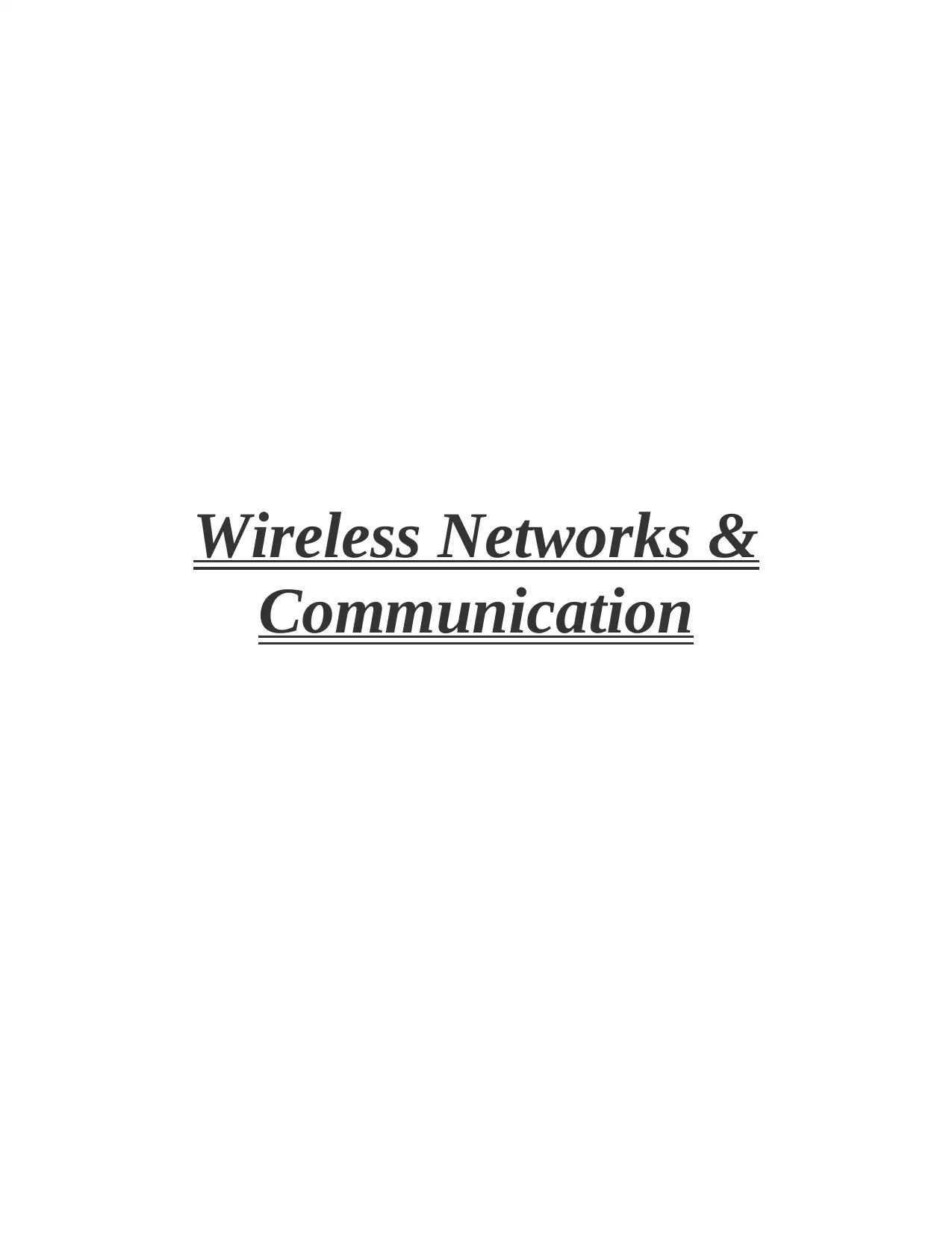
Wireless Networks &
Communication
Communication
Secure Best Marks with AI Grader
Need help grading? Try our AI Grader for instant feedback on your assignments.
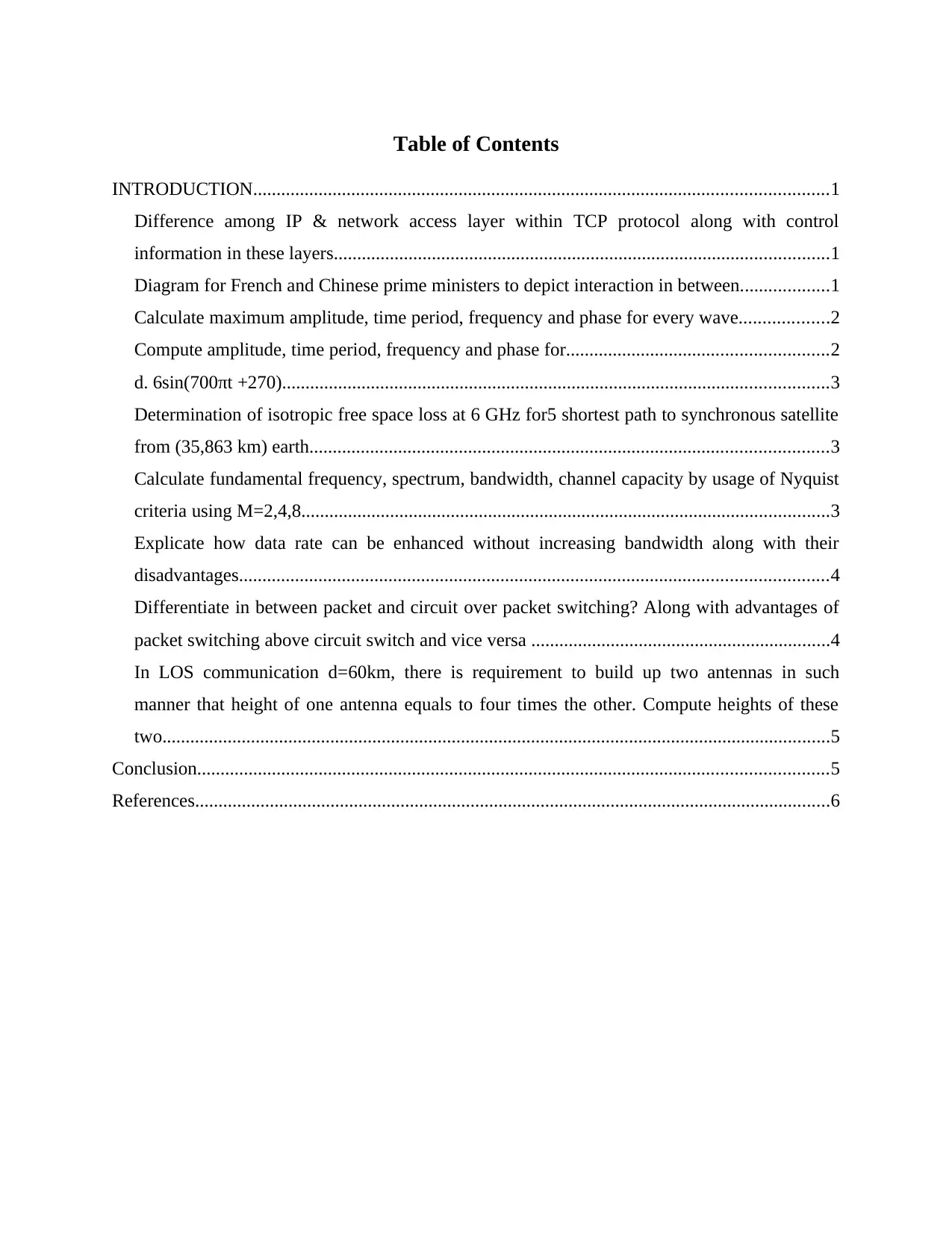
Table of Contents
INTRODUCTION...........................................................................................................................1
Difference among IP & network access layer within TCP protocol along with control
information in these layers..........................................................................................................1
Diagram for French and Chinese prime ministers to depict interaction in between...................1
Calculate maximum amplitude, time period, frequency and phase for every wave...................2
Compute amplitude, time period, frequency and phase for........................................................2
d. 6sin(700πt +270).....................................................................................................................3
Determination of isotropic free space loss at 6 GHz for5 shortest path to synchronous satellite
from (35,863 km) earth...............................................................................................................3
Calculate fundamental frequency, spectrum, bandwidth, channel capacity by usage of Nyquist
criteria using M=2,4,8.................................................................................................................3
Explicate how data rate can be enhanced without increasing bandwidth along with their
disadvantages..............................................................................................................................4
Differentiate in between packet and circuit over packet switching? Along with advantages of
packet switching above circuit switch and vice versa ................................................................4
In LOS communication d=60km, there is requirement to build up two antennas in such
manner that height of one antenna equals to four times the other. Compute heights of these
two...............................................................................................................................................5
Conclusion.......................................................................................................................................5
References........................................................................................................................................6
INTRODUCTION...........................................................................................................................1
Difference among IP & network access layer within TCP protocol along with control
information in these layers..........................................................................................................1
Diagram for French and Chinese prime ministers to depict interaction in between...................1
Calculate maximum amplitude, time period, frequency and phase for every wave...................2
Compute amplitude, time period, frequency and phase for........................................................2
d. 6sin(700πt +270).....................................................................................................................3
Determination of isotropic free space loss at 6 GHz for5 shortest path to synchronous satellite
from (35,863 km) earth...............................................................................................................3
Calculate fundamental frequency, spectrum, bandwidth, channel capacity by usage of Nyquist
criteria using M=2,4,8.................................................................................................................3
Explicate how data rate can be enhanced without increasing bandwidth along with their
disadvantages..............................................................................................................................4
Differentiate in between packet and circuit over packet switching? Along with advantages of
packet switching above circuit switch and vice versa ................................................................4
In LOS communication d=60km, there is requirement to build up two antennas in such
manner that height of one antenna equals to four times the other. Compute heights of these
two...............................................................................................................................................5
Conclusion.......................................................................................................................................5
References........................................................................................................................................6
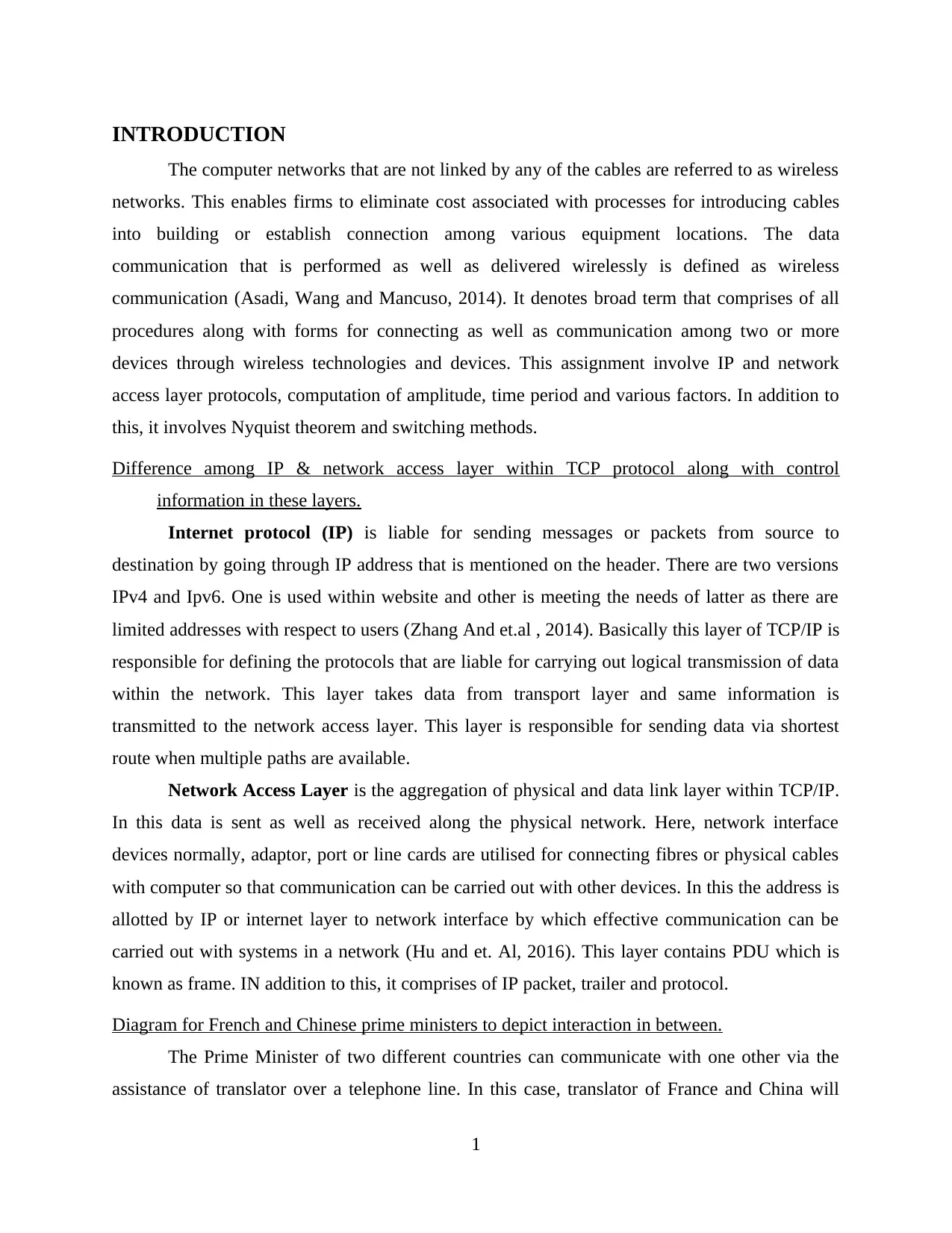
INTRODUCTION
The computer networks that are not linked by any of the cables are referred to as wireless
networks. This enables firms to eliminate cost associated with processes for introducing cables
into building or establish connection among various equipment locations. The data
communication that is performed as well as delivered wirelessly is defined as wireless
communication (Asadi, Wang and Mancuso, 2014). It denotes broad term that comprises of all
procedures along with forms for connecting as well as communication among two or more
devices through wireless technologies and devices. This assignment involve IP and network
access layer protocols, computation of amplitude, time period and various factors. In addition to
this, it involves Nyquist theorem and switching methods.
Difference among IP & network access layer within TCP protocol along with control
information in these layers.
Internet protocol (IP) is liable for sending messages or packets from source to
destination by going through IP address that is mentioned on the header. There are two versions
IPv4 and Ipv6. One is used within website and other is meeting the needs of latter as there are
limited addresses with respect to users (Zhang And et.al , 2014). Basically this layer of TCP/IP is
responsible for defining the protocols that are liable for carrying out logical transmission of data
within the network. This layer takes data from transport layer and same information is
transmitted to the network access layer. This layer is responsible for sending data via shortest
route when multiple paths are available.
Network Access Layer is the aggregation of physical and data link layer within TCP/IP.
In this data is sent as well as received along the physical network. Here, network interface
devices normally, adaptor, port or line cards are utilised for connecting fibres or physical cables
with computer so that communication can be carried out with other devices. In this the address is
allotted by IP or internet layer to network interface by which effective communication can be
carried out with systems in a network (Hu and et. Al, 2016). This layer contains PDU which is
known as frame. IN addition to this, it comprises of IP packet, trailer and protocol.
Diagram for French and Chinese prime ministers to depict interaction in between.
The Prime Minister of two different countries can communicate with one other via the
assistance of translator over a telephone line. In this case, translator of France and China will
1
The computer networks that are not linked by any of the cables are referred to as wireless
networks. This enables firms to eliminate cost associated with processes for introducing cables
into building or establish connection among various equipment locations. The data
communication that is performed as well as delivered wirelessly is defined as wireless
communication (Asadi, Wang and Mancuso, 2014). It denotes broad term that comprises of all
procedures along with forms for connecting as well as communication among two or more
devices through wireless technologies and devices. This assignment involve IP and network
access layer protocols, computation of amplitude, time period and various factors. In addition to
this, it involves Nyquist theorem and switching methods.
Difference among IP & network access layer within TCP protocol along with control
information in these layers.
Internet protocol (IP) is liable for sending messages or packets from source to
destination by going through IP address that is mentioned on the header. There are two versions
IPv4 and Ipv6. One is used within website and other is meeting the needs of latter as there are
limited addresses with respect to users (Zhang And et.al , 2014). Basically this layer of TCP/IP is
responsible for defining the protocols that are liable for carrying out logical transmission of data
within the network. This layer takes data from transport layer and same information is
transmitted to the network access layer. This layer is responsible for sending data via shortest
route when multiple paths are available.
Network Access Layer is the aggregation of physical and data link layer within TCP/IP.
In this data is sent as well as received along the physical network. Here, network interface
devices normally, adaptor, port or line cards are utilised for connecting fibres or physical cables
with computer so that communication can be carried out with other devices. In this the address is
allotted by IP or internet layer to network interface by which effective communication can be
carried out with systems in a network (Hu and et. Al, 2016). This layer contains PDU which is
known as frame. IN addition to this, it comprises of IP packet, trailer and protocol.
Diagram for French and Chinese prime ministers to depict interaction in between.
The Prime Minister of two different countries can communicate with one other via the
assistance of translator over a telephone line. In this case, translator of France and China will
1
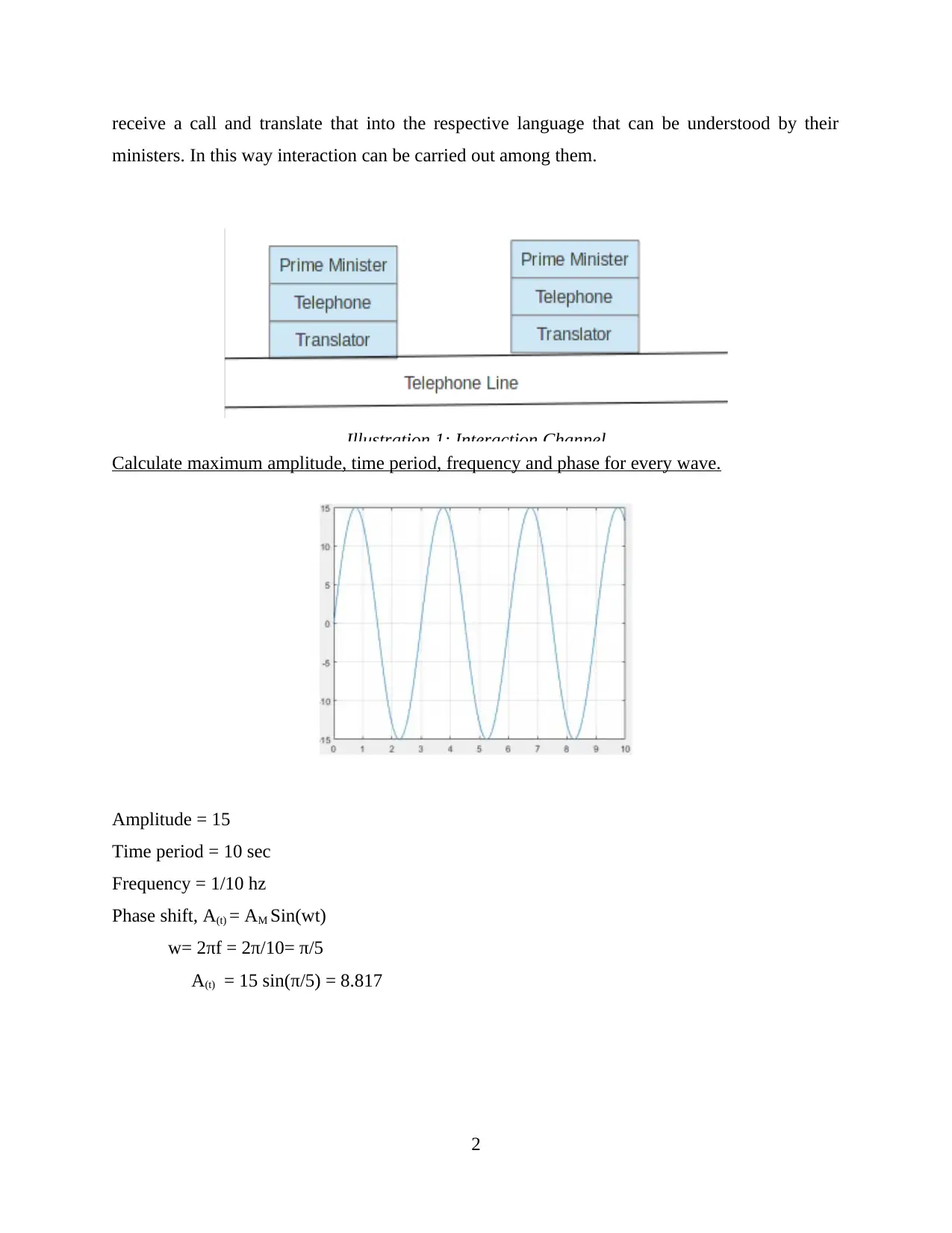
receive a call and translate that into the respective language that can be understood by their
ministers. In this way interaction can be carried out among them.
Calculate maximum amplitude, time period, frequency and phase for every wave.
Amplitude = 15
Time period = 10 sec
Frequency = 1/10 hz
Phase shift, A(t) = AM Sin(wt)
w= 2πf = 2π/10= π/5
A(t) = 15 sin(π/5) = 8.817
2
Illustration 1: Interaction Channel
ministers. In this way interaction can be carried out among them.
Calculate maximum amplitude, time period, frequency and phase for every wave.
Amplitude = 15
Time period = 10 sec
Frequency = 1/10 hz
Phase shift, A(t) = AM Sin(wt)
w= 2πf = 2π/10= π/5
A(t) = 15 sin(π/5) = 8.817
2
Illustration 1: Interaction Channel
Paraphrase This Document
Need a fresh take? Get an instant paraphrase of this document with our AI Paraphraser
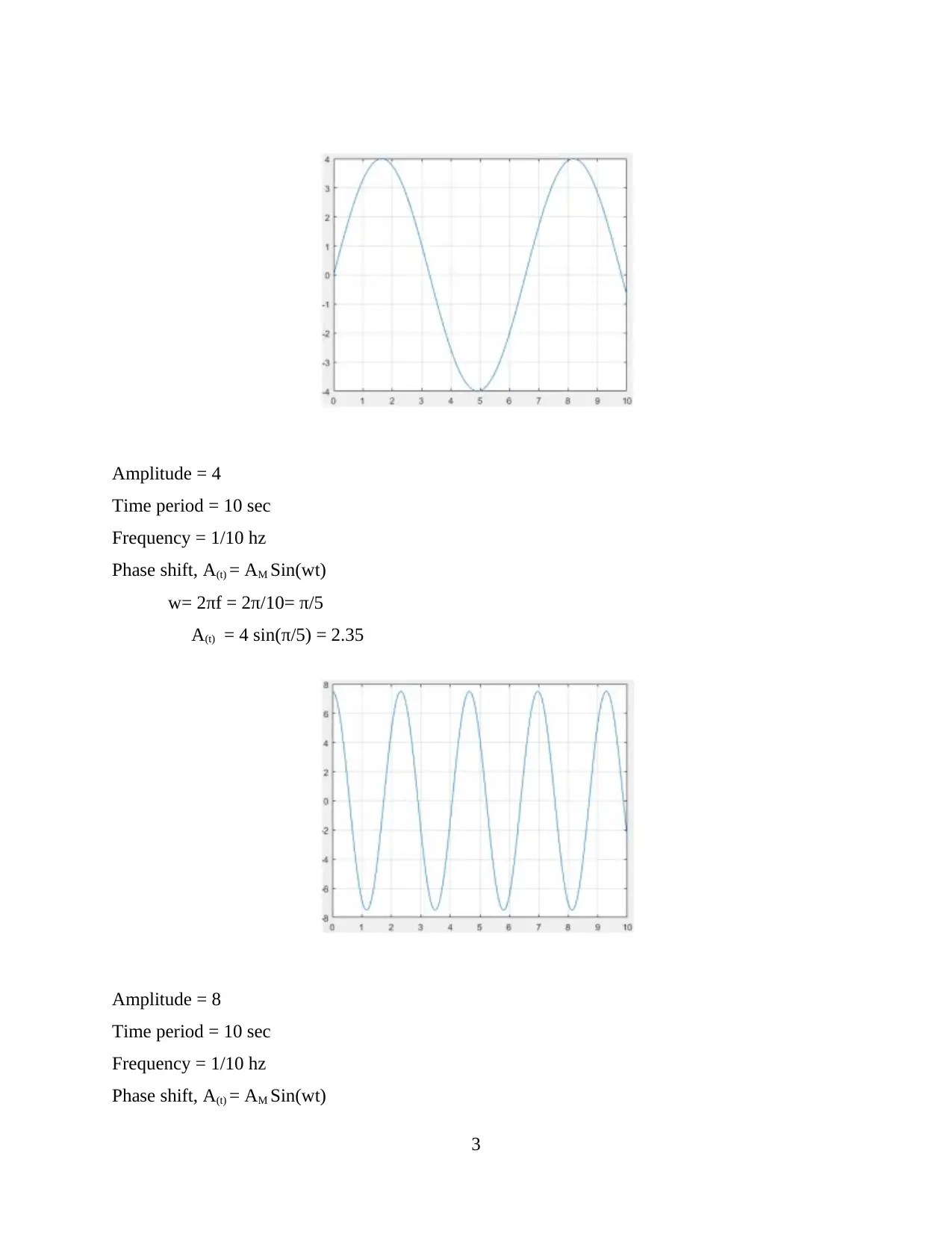
Amplitude = 4
Time period = 10 sec
Frequency = 1/10 hz
Phase shift, A(t) = AM Sin(wt)
w= 2πf = 2π/10= π/5
A(t) = 4 sin(π/5) = 2.35
Amplitude = 8
Time period = 10 sec
Frequency = 1/10 hz
Phase shift, A(t) = AM Sin(wt)
3
Time period = 10 sec
Frequency = 1/10 hz
Phase shift, A(t) = AM Sin(wt)
w= 2πf = 2π/10= π/5
A(t) = 4 sin(π/5) = 2.35
Amplitude = 8
Time period = 10 sec
Frequency = 1/10 hz
Phase shift, A(t) = AM Sin(wt)
3
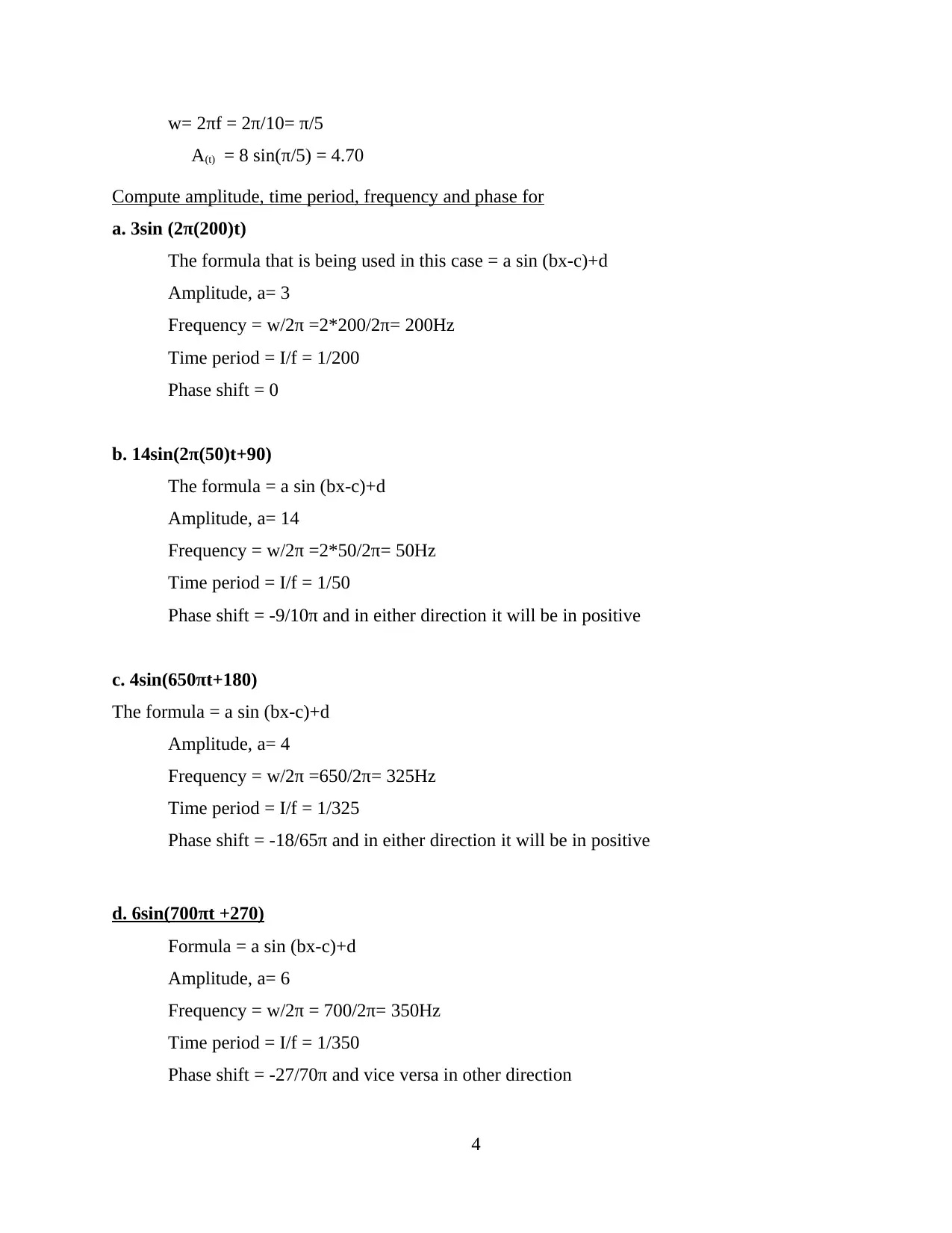
w= 2πf = 2π/10= π/5
A(t) = 8 sin(π/5) = 4.70
Compute amplitude, time period, frequency and phase for
a. 3sin (2π(200)t)
The formula that is being used in this case = a sin (bx-c)+d
Amplitude, a= 3
Frequency = w/2π =2*200/2π= 200Hz
Time period = I/f = 1/200
Phase shift = 0
b. 14sin(2π(50)t+90)
The formula = a sin (bx-c)+d
Amplitude, a= 14
Frequency = w/2π =2*50/2π= 50Hz
Time period = I/f = 1/50
Phase shift = -9/10π and in either direction it will be in positive
c. 4sin(650πt+180)
The formula = a sin (bx-c)+d
Amplitude, a= 4
Frequency = w/2π =650/2π= 325Hz
Time period = I/f = 1/325
Phase shift = -18/65π and in either direction it will be in positive
d. 6sin(700πt +270)
Formula = a sin (bx-c)+d
Amplitude, a= 6
Frequency = w/2π = 700/2π= 350Hz
Time period = I/f = 1/350
Phase shift = -27/70π and vice versa in other direction
4
A(t) = 8 sin(π/5) = 4.70
Compute amplitude, time period, frequency and phase for
a. 3sin (2π(200)t)
The formula that is being used in this case = a sin (bx-c)+d
Amplitude, a= 3
Frequency = w/2π =2*200/2π= 200Hz
Time period = I/f = 1/200
Phase shift = 0
b. 14sin(2π(50)t+90)
The formula = a sin (bx-c)+d
Amplitude, a= 14
Frequency = w/2π =2*50/2π= 50Hz
Time period = I/f = 1/50
Phase shift = -9/10π and in either direction it will be in positive
c. 4sin(650πt+180)
The formula = a sin (bx-c)+d
Amplitude, a= 4
Frequency = w/2π =650/2π= 325Hz
Time period = I/f = 1/325
Phase shift = -18/65π and in either direction it will be in positive
d. 6sin(700πt +270)
Formula = a sin (bx-c)+d
Amplitude, a= 6
Frequency = w/2π = 700/2π= 350Hz
Time period = I/f = 1/350
Phase shift = -27/70π and vice versa in other direction
4
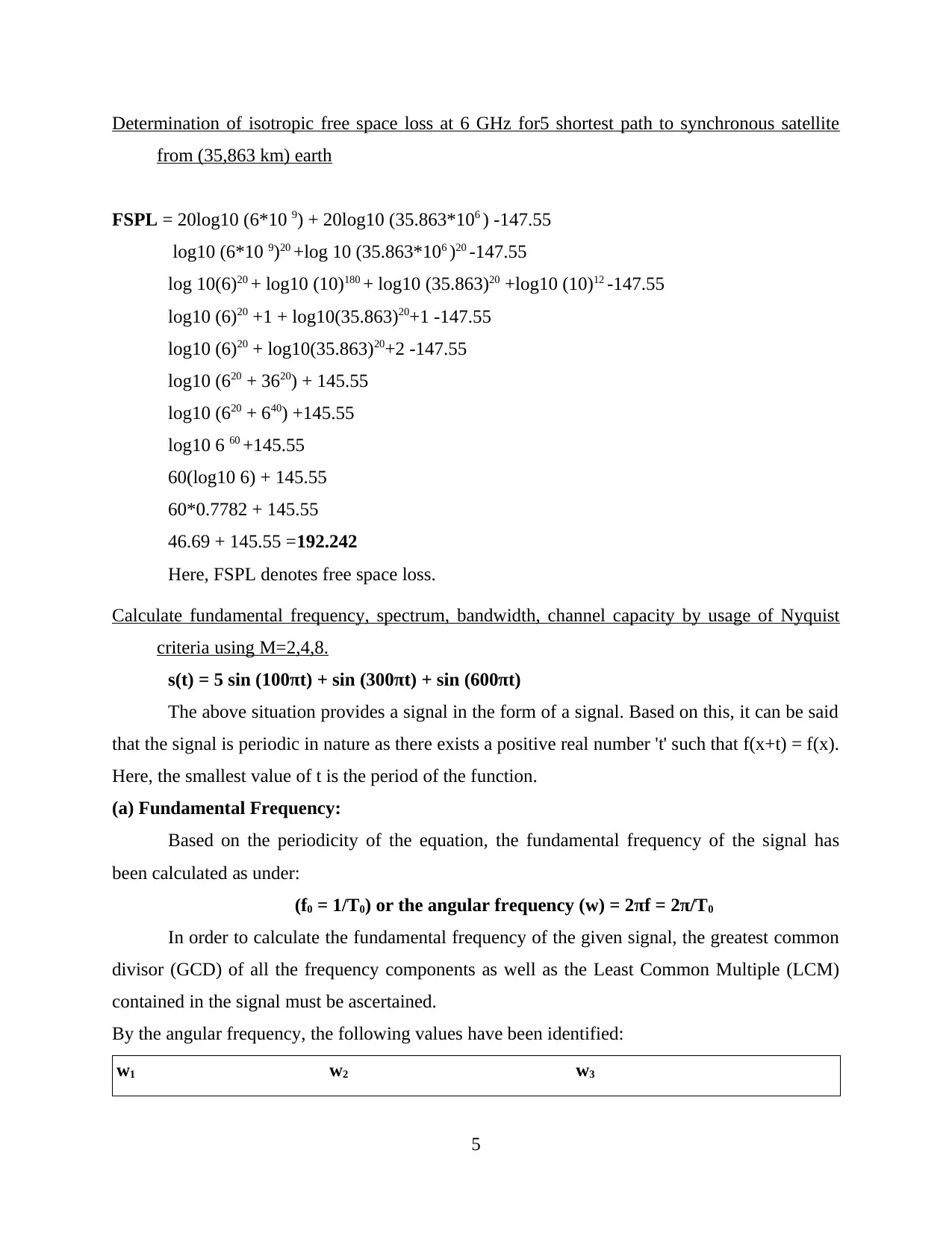
Determination of isotropic free space loss at 6 GHz for5 shortest path to synchronous satellite
from (35,863 km) earth
FSPL = 20log10 (6*10 9) + 20log10 (35.863*106 ) -147.55
log10 (6*10 9)20 +log 10 (35.863*106 )20 -147.55
log 10(6)20 + log10 (10)180 + log10 (35.863)20 +log10 (10)12 -147.55
log10 (6)20 +1 + log10(35.863)20+1 -147.55
log10 (6)20 + log10(35.863)20+2 -147.55
log10 (620 + 3620) + 145.55
log10 (620 + 640) +145.55
log10 6 60 +145.55
60(log10 6) + 145.55
60*0.7782 + 145.55
46.69 + 145.55 =192.242
Here, FSPL denotes free space loss.
Calculate fundamental frequency, spectrum, bandwidth, channel capacity by usage of Nyquist
criteria using M=2,4,8.
s(t) = 5 sin (100πt) + sin (300πt) + sin (600πt)
The above situation provides a signal in the form of a signal. Based on this, it can be said
that the signal is periodic in nature as there exists a positive real number 't' such that f(x+t) = f(x).
Here, the smallest value of t is the period of the function.
(a) Fundamental Frequency:
Based on the periodicity of the equation, the fundamental frequency of the signal has
been calculated as under:
(f0 = 1/T0) or the angular frequency (w) = 2πf = 2π/T0
In order to calculate the fundamental frequency of the given signal, the greatest common
divisor (GCD) of all the frequency components as well as the Least Common Multiple (LCM)
contained in the signal must be ascertained.
By the angular frequency, the following values have been identified:
w1 w2 w3
5
from (35,863 km) earth
FSPL = 20log10 (6*10 9) + 20log10 (35.863*106 ) -147.55
log10 (6*10 9)20 +log 10 (35.863*106 )20 -147.55
log 10(6)20 + log10 (10)180 + log10 (35.863)20 +log10 (10)12 -147.55
log10 (6)20 +1 + log10(35.863)20+1 -147.55
log10 (6)20 + log10(35.863)20+2 -147.55
log10 (620 + 3620) + 145.55
log10 (620 + 640) +145.55
log10 6 60 +145.55
60(log10 6) + 145.55
60*0.7782 + 145.55
46.69 + 145.55 =192.242
Here, FSPL denotes free space loss.
Calculate fundamental frequency, spectrum, bandwidth, channel capacity by usage of Nyquist
criteria using M=2,4,8.
s(t) = 5 sin (100πt) + sin (300πt) + sin (600πt)
The above situation provides a signal in the form of a signal. Based on this, it can be said
that the signal is periodic in nature as there exists a positive real number 't' such that f(x+t) = f(x).
Here, the smallest value of t is the period of the function.
(a) Fundamental Frequency:
Based on the periodicity of the equation, the fundamental frequency of the signal has
been calculated as under:
(f0 = 1/T0) or the angular frequency (w) = 2πf = 2π/T0
In order to calculate the fundamental frequency of the given signal, the greatest common
divisor (GCD) of all the frequency components as well as the Least Common Multiple (LCM)
contained in the signal must be ascertained.
By the angular frequency, the following values have been identified:
w1 w2 w3
5
Secure Best Marks with AI Grader
Need help grading? Try our AI Grader for instant feedback on your assignments.
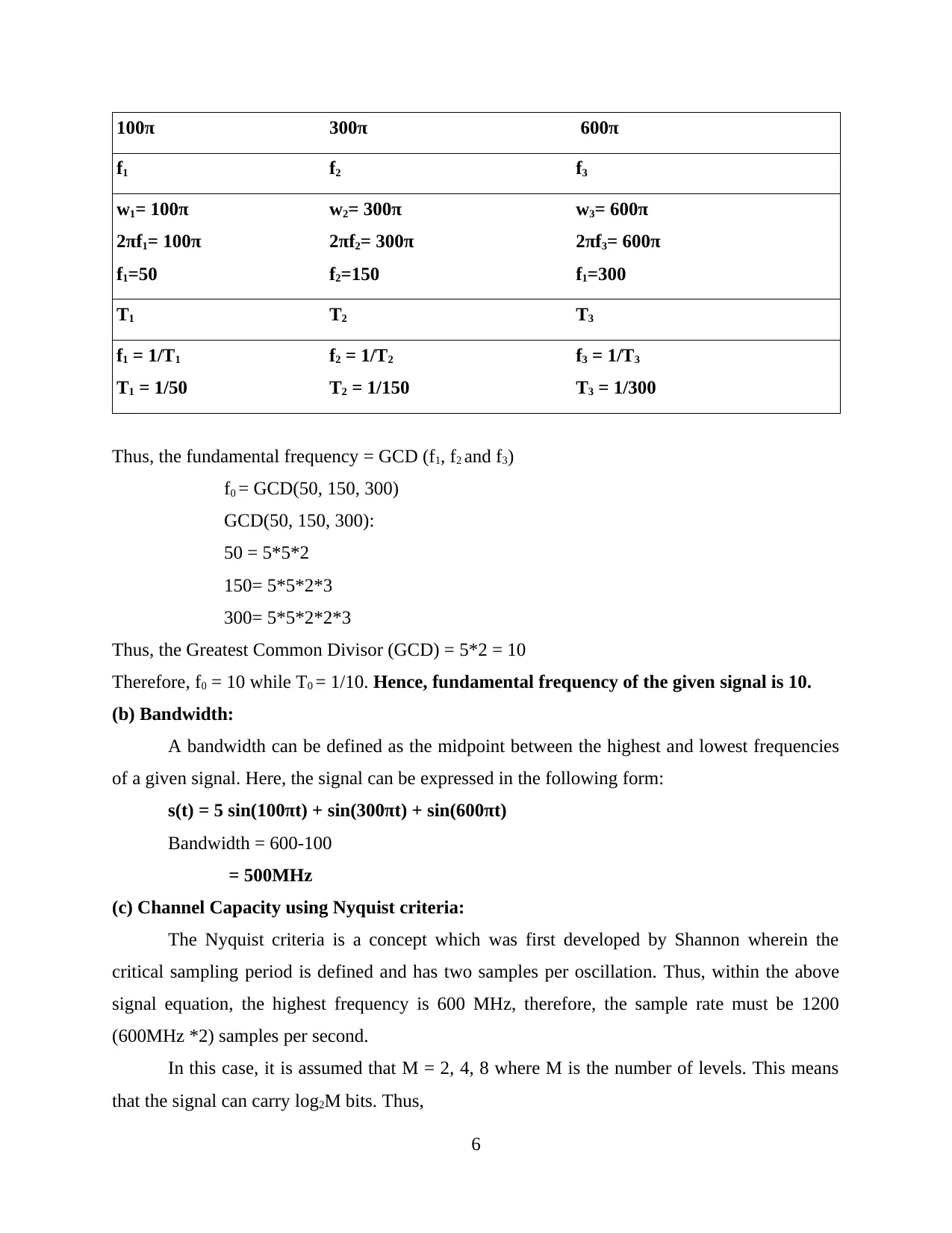
100π 300π 600π
f1 f2 f3
w1= 100π
2πf1= 100π
f1=50
w2= 300π
2πf2= 300π
f2=150
w3= 600π
2πf3= 600π
f1=300
T1 T2 T3
f1 = 1/T1
T1 = 1/50
f2 = 1/T2
T2 = 1/150
f3 = 1/T3
T3 = 1/300
Thus, the fundamental frequency = GCD (f1, f2 and f3)
f0 = GCD(50, 150, 300)
GCD(50, 150, 300):
50 = 5*5*2
150= 5*5*2*3
300= 5*5*2*2*3
Thus, the Greatest Common Divisor (GCD) = 5*2 = 10
Therefore, f0 = 10 while T0 = 1/10. Hence, fundamental frequency of the given signal is 10.
(b) Bandwidth:
A bandwidth can be defined as the midpoint between the highest and lowest frequencies
of a given signal. Here, the signal can be expressed in the following form:
s(t) = 5 sin(100πt) + sin(300πt) + sin(600πt)
Bandwidth = 600-100
= 500MHz
(c) Channel Capacity using Nyquist criteria:
The Nyquist criteria is a concept which was first developed by Shannon wherein the
critical sampling period is defined and has two samples per oscillation. Thus, within the above
signal equation, the highest frequency is 600 MHz, therefore, the sample rate must be 1200
(600MHz *2) samples per second.
In this case, it is assumed that M = 2, 4, 8 where M is the number of levels. This means
that the signal can carry log2M bits. Thus,
6
f1 f2 f3
w1= 100π
2πf1= 100π
f1=50
w2= 300π
2πf2= 300π
f2=150
w3= 600π
2πf3= 600π
f1=300
T1 T2 T3
f1 = 1/T1
T1 = 1/50
f2 = 1/T2
T2 = 1/150
f3 = 1/T3
T3 = 1/300
Thus, the fundamental frequency = GCD (f1, f2 and f3)
f0 = GCD(50, 150, 300)
GCD(50, 150, 300):
50 = 5*5*2
150= 5*5*2*3
300= 5*5*2*2*3
Thus, the Greatest Common Divisor (GCD) = 5*2 = 10
Therefore, f0 = 10 while T0 = 1/10. Hence, fundamental frequency of the given signal is 10.
(b) Bandwidth:
A bandwidth can be defined as the midpoint between the highest and lowest frequencies
of a given signal. Here, the signal can be expressed in the following form:
s(t) = 5 sin(100πt) + sin(300πt) + sin(600πt)
Bandwidth = 600-100
= 500MHz
(c) Channel Capacity using Nyquist criteria:
The Nyquist criteria is a concept which was first developed by Shannon wherein the
critical sampling period is defined and has two samples per oscillation. Thus, within the above
signal equation, the highest frequency is 600 MHz, therefore, the sample rate must be 1200
(600MHz *2) samples per second.
In this case, it is assumed that M = 2, 4, 8 where M is the number of levels. This means
that the signal can carry log2M bits. Thus,
6
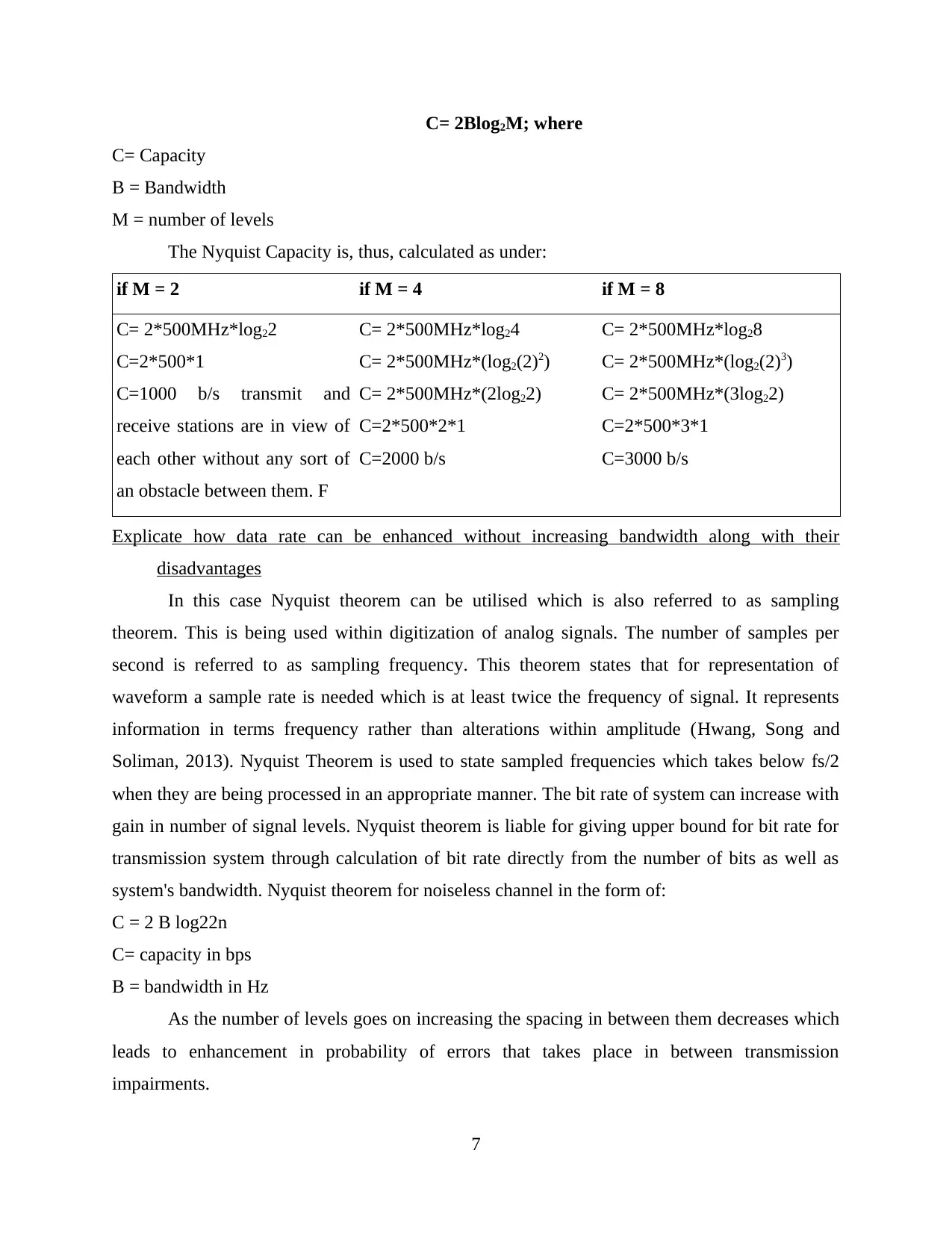
C= 2Blog2M; where
C= Capacity
B = Bandwidth
M = number of levels
The Nyquist Capacity is, thus, calculated as under:
if M = 2 if M = 4 if M = 8
C= 2*500MHz*log22
C=2*500*1
C=1000 b/s transmit and
receive stations are in view of
each other without any sort of
an obstacle between them. F
C= 2*500MHz*log24
C= 2*500MHz*(log2(2)2)
C= 2*500MHz*(2log22)
C=2*500*2*1
C=2000 b/s
C= 2*500MHz*log28
C= 2*500MHz*(log2(2)3)
C= 2*500MHz*(3log22)
C=2*500*3*1
C=3000 b/s
Explicate how data rate can be enhanced without increasing bandwidth along with their
disadvantages
In this case Nyquist theorem can be utilised which is also referred to as sampling
theorem. This is being used within digitization of analog signals. The number of samples per
second is referred to as sampling frequency. This theorem states that for representation of
waveform a sample rate is needed which is at least twice the frequency of signal. It represents
information in terms frequency rather than alterations within amplitude (Hwang, Song and
Soliman, 2013). Nyquist Theorem is used to state sampled frequencies which takes below fs/2
when they are being processed in an appropriate manner. The bit rate of system can increase with
gain in number of signal levels. Nyquist theorem is liable for giving upper bound for bit rate for
transmission system through calculation of bit rate directly from the number of bits as well as
system's bandwidth. Nyquist theorem for noiseless channel in the form of:
C = 2 B log22n
C= capacity in bps
B = bandwidth in Hz
As the number of levels goes on increasing the spacing in between them decreases which
leads to enhancement in probability of errors that takes place in between transmission
impairments.
7
C= Capacity
B = Bandwidth
M = number of levels
The Nyquist Capacity is, thus, calculated as under:
if M = 2 if M = 4 if M = 8
C= 2*500MHz*log22
C=2*500*1
C=1000 b/s transmit and
receive stations are in view of
each other without any sort of
an obstacle between them. F
C= 2*500MHz*log24
C= 2*500MHz*(log2(2)2)
C= 2*500MHz*(2log22)
C=2*500*2*1
C=2000 b/s
C= 2*500MHz*log28
C= 2*500MHz*(log2(2)3)
C= 2*500MHz*(3log22)
C=2*500*3*1
C=3000 b/s
Explicate how data rate can be enhanced without increasing bandwidth along with their
disadvantages
In this case Nyquist theorem can be utilised which is also referred to as sampling
theorem. This is being used within digitization of analog signals. The number of samples per
second is referred to as sampling frequency. This theorem states that for representation of
waveform a sample rate is needed which is at least twice the frequency of signal. It represents
information in terms frequency rather than alterations within amplitude (Hwang, Song and
Soliman, 2013). Nyquist Theorem is used to state sampled frequencies which takes below fs/2
when they are being processed in an appropriate manner. The bit rate of system can increase with
gain in number of signal levels. Nyquist theorem is liable for giving upper bound for bit rate for
transmission system through calculation of bit rate directly from the number of bits as well as
system's bandwidth. Nyquist theorem for noiseless channel in the form of:
C = 2 B log22n
C= capacity in bps
B = bandwidth in Hz
As the number of levels goes on increasing the spacing in between them decreases which
leads to enhancement in probability of errors that takes place in between transmission
impairments.
7
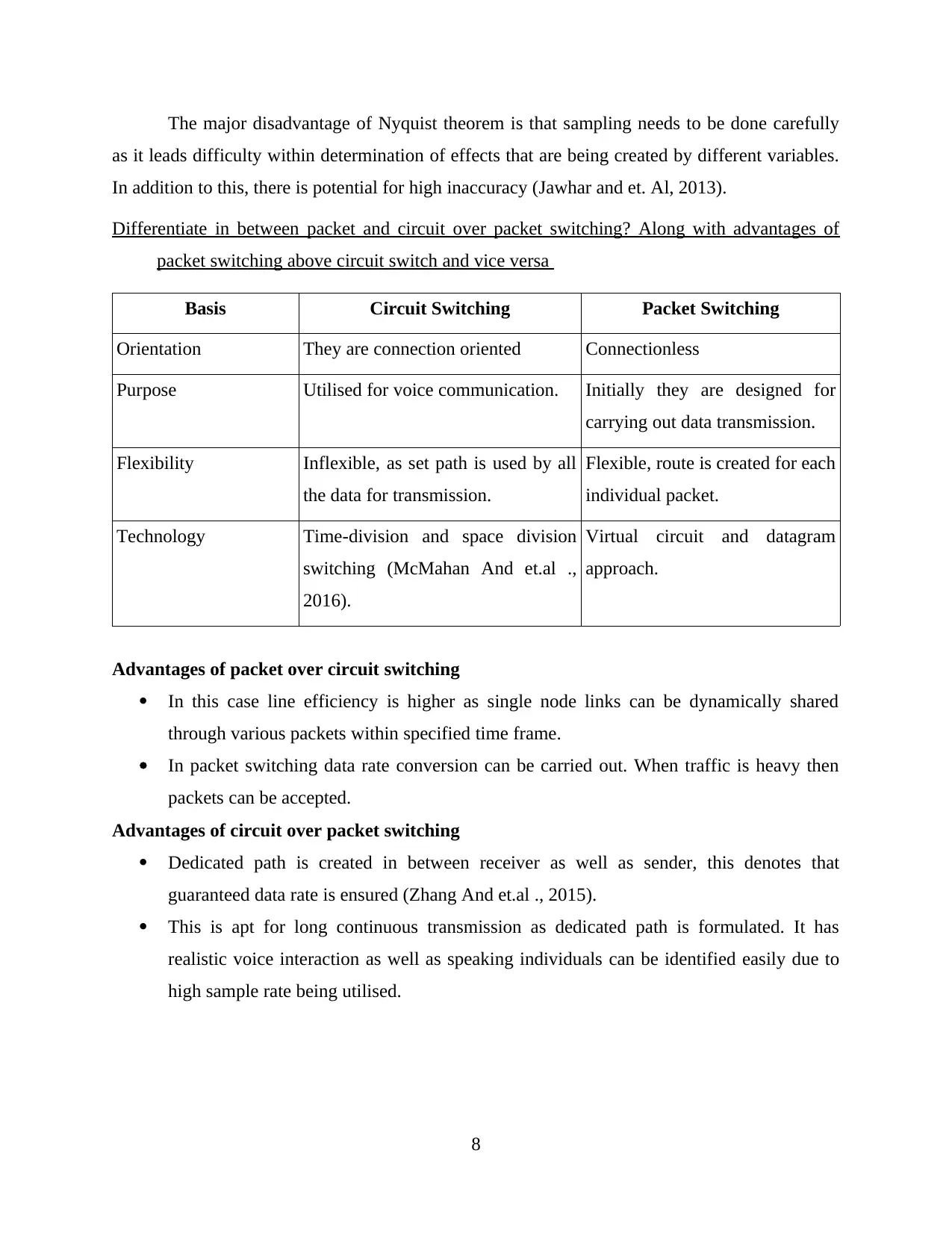
The major disadvantage of Nyquist theorem is that sampling needs to be done carefully
as it leads difficulty within determination of effects that are being created by different variables.
In addition to this, there is potential for high inaccuracy (Jawhar and et. Al, 2013).
Differentiate in between packet and circuit over packet switching? Along with advantages of
packet switching above circuit switch and vice versa
Basis Circuit Switching Packet Switching
Orientation They are connection oriented Connectionless
Purpose Utilised for voice communication. Initially they are designed for
carrying out data transmission.
Flexibility Inflexible, as set path is used by all
the data for transmission.
Flexible, route is created for each
individual packet.
Technology Time-division and space division
switching (McMahan And et.al .,
2016).
Virtual circuit and datagram
approach.
Advantages of packet over circuit switching
In this case line efficiency is higher as single node links can be dynamically shared
through various packets within specified time frame.
In packet switching data rate conversion can be carried out. When traffic is heavy then
packets can be accepted.
Advantages of circuit over packet switching
Dedicated path is created in between receiver as well as sender, this denotes that
guaranteed data rate is ensured (Zhang And et.al ., 2015).
This is apt for long continuous transmission as dedicated path is formulated. It has
realistic voice interaction as well as speaking individuals can be identified easily due to
high sample rate being utilised.
8
as it leads difficulty within determination of effects that are being created by different variables.
In addition to this, there is potential for high inaccuracy (Jawhar and et. Al, 2013).
Differentiate in between packet and circuit over packet switching? Along with advantages of
packet switching above circuit switch and vice versa
Basis Circuit Switching Packet Switching
Orientation They are connection oriented Connectionless
Purpose Utilised for voice communication. Initially they are designed for
carrying out data transmission.
Flexibility Inflexible, as set path is used by all
the data for transmission.
Flexible, route is created for each
individual packet.
Technology Time-division and space division
switching (McMahan And et.al .,
2016).
Virtual circuit and datagram
approach.
Advantages of packet over circuit switching
In this case line efficiency is higher as single node links can be dynamically shared
through various packets within specified time frame.
In packet switching data rate conversion can be carried out. When traffic is heavy then
packets can be accepted.
Advantages of circuit over packet switching
Dedicated path is created in between receiver as well as sender, this denotes that
guaranteed data rate is ensured (Zhang And et.al ., 2015).
This is apt for long continuous transmission as dedicated path is formulated. It has
realistic voice interaction as well as speaking individuals can be identified easily due to
high sample rate being utilised.
8
Paraphrase This Document
Need a fresh take? Get an instant paraphrase of this document with our AI Paraphraser
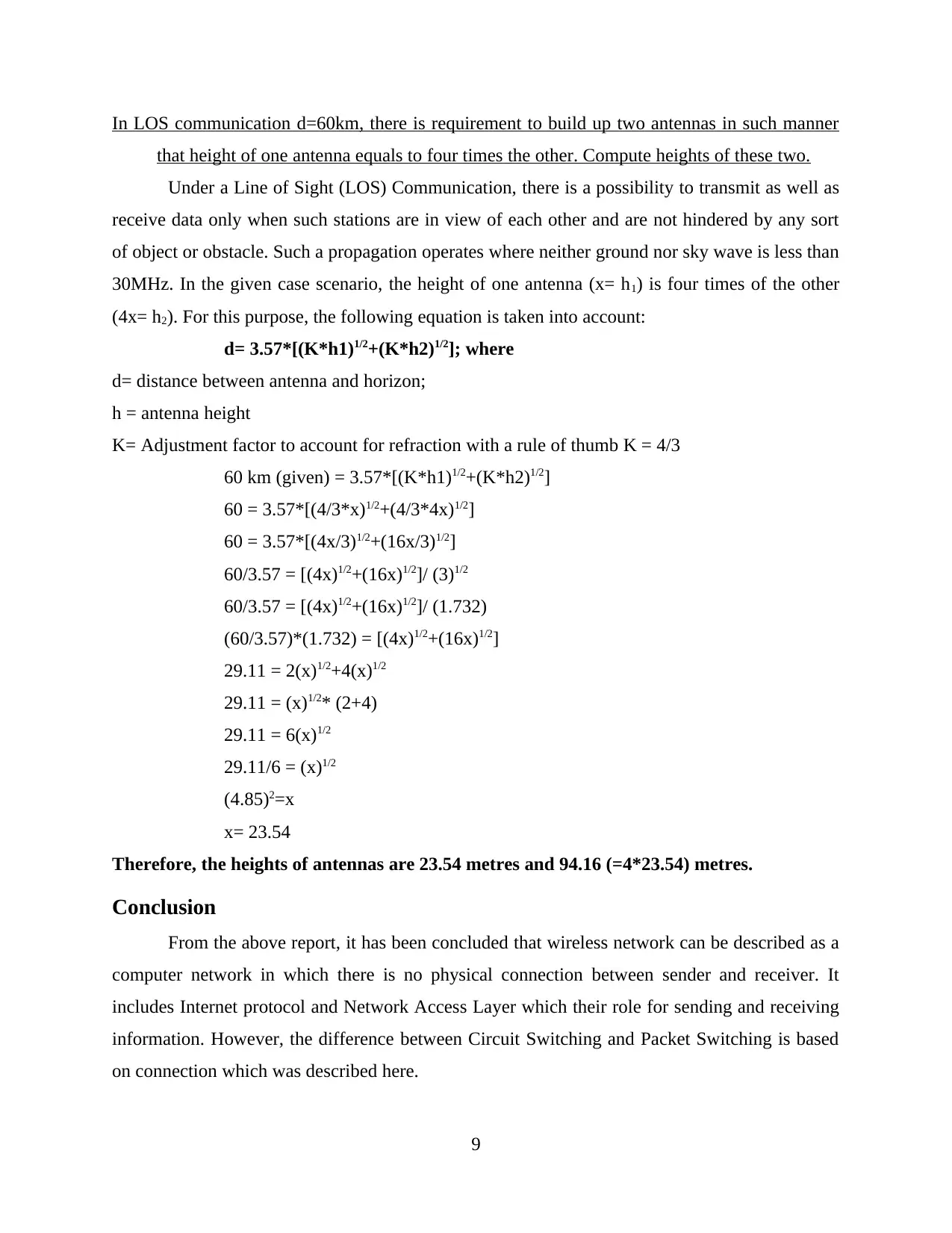
In LOS communication d=60km, there is requirement to build up two antennas in such manner
that height of one antenna equals to four times the other. Compute heights of these two.
Under a Line of Sight (LOS) Communication, there is a possibility to transmit as well as
receive data only when such stations are in view of each other and are not hindered by any sort
of object or obstacle. Such a propagation operates where neither ground nor sky wave is less than
30MHz. In the given case scenario, the height of one antenna (x= h1) is four times of the other
(4x= h2). For this purpose, the following equation is taken into account:
d= 3.57*[(K*h1)1/2+(K*h2)1/2]; where
d= distance between antenna and horizon;
h = antenna height
K= Adjustment factor to account for refraction with a rule of thumb K = 4/3
60 km (given) = 3.57*[(K*h1)1/2+(K*h2)1/2]
60 = 3.57*[(4/3*x)1/2+(4/3*4x)1/2]
60 = 3.57*[(4x/3)1/2+(16x/3)1/2]
60/3.57 = [(4x)1/2+(16x)1/2]/ (3)1/2
60/3.57 = [(4x)1/2+(16x)1/2]/ (1.732)
(60/3.57)*(1.732) = [(4x)1/2+(16x)1/2]
29.11 = 2(x)1/2+4(x)1/2
29.11 = (x)1/2* (2+4)
29.11 = 6(x)1/2
29.11/6 = (x)1/2
(4.85)2=x
x= 23.54
Therefore, the heights of antennas are 23.54 metres and 94.16 (=4*23.54) metres.
Conclusion
From the above report, it has been concluded that wireless network can be described as a
computer network in which there is no physical connection between sender and receiver. It
includes Internet protocol and Network Access Layer which their role for sending and receiving
information. However, the difference between Circuit Switching and Packet Switching is based
on connection which was described here.
9
that height of one antenna equals to four times the other. Compute heights of these two.
Under a Line of Sight (LOS) Communication, there is a possibility to transmit as well as
receive data only when such stations are in view of each other and are not hindered by any sort
of object or obstacle. Such a propagation operates where neither ground nor sky wave is less than
30MHz. In the given case scenario, the height of one antenna (x= h1) is four times of the other
(4x= h2). For this purpose, the following equation is taken into account:
d= 3.57*[(K*h1)1/2+(K*h2)1/2]; where
d= distance between antenna and horizon;
h = antenna height
K= Adjustment factor to account for refraction with a rule of thumb K = 4/3
60 km (given) = 3.57*[(K*h1)1/2+(K*h2)1/2]
60 = 3.57*[(4/3*x)1/2+(4/3*4x)1/2]
60 = 3.57*[(4x/3)1/2+(16x/3)1/2]
60/3.57 = [(4x)1/2+(16x)1/2]/ (3)1/2
60/3.57 = [(4x)1/2+(16x)1/2]/ (1.732)
(60/3.57)*(1.732) = [(4x)1/2+(16x)1/2]
29.11 = 2(x)1/2+4(x)1/2
29.11 = (x)1/2* (2+4)
29.11 = 6(x)1/2
29.11/6 = (x)1/2
(4.85)2=x
x= 23.54
Therefore, the heights of antennas are 23.54 metres and 94.16 (=4*23.54) metres.
Conclusion
From the above report, it has been concluded that wireless network can be described as a
computer network in which there is no physical connection between sender and receiver. It
includes Internet protocol and Network Access Layer which their role for sending and receiving
information. However, the difference between Circuit Switching and Packet Switching is based
on connection which was described here.
9
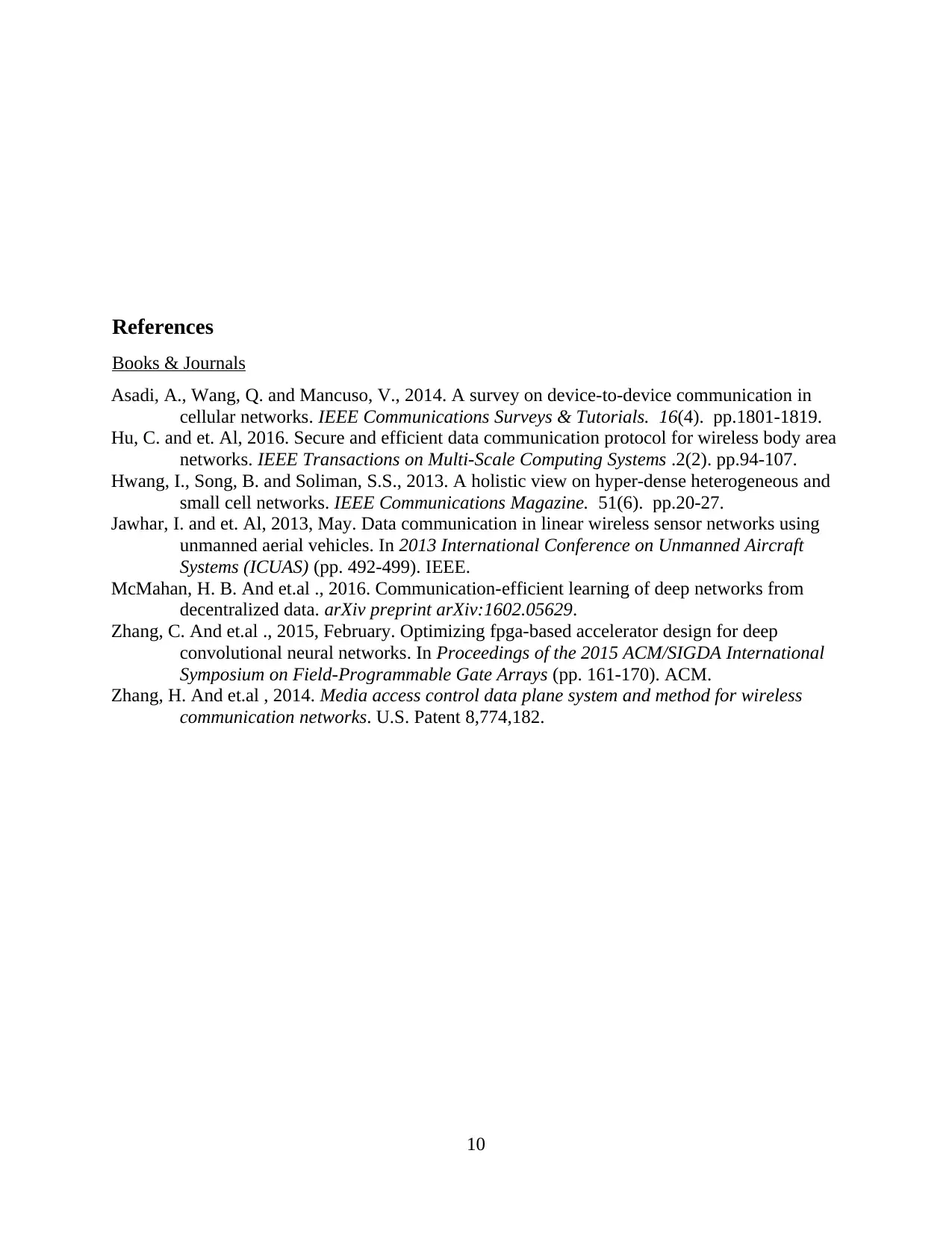
References
Books & Journals
Asadi, A., Wang, Q. and Mancuso, V., 2014. A survey on device-to-device communication in
cellular networks. IEEE Communications Surveys & Tutorials. 16(4). pp.1801-1819.
Hu, C. and et. Al, 2016. Secure and efficient data communication protocol for wireless body area
networks. IEEE Transactions on Multi-Scale Computing Systems .2(2). pp.94-107.
Hwang, I., Song, B. and Soliman, S.S., 2013. A holistic view on hyper-dense heterogeneous and
small cell networks. IEEE Communications Magazine. 51(6). pp.20-27.
Jawhar, I. and et. Al, 2013, May. Data communication in linear wireless sensor networks using
unmanned aerial vehicles. In 2013 International Conference on Unmanned Aircraft
Systems (ICUAS) (pp. 492-499). IEEE.
McMahan, H. B. And et.al ., 2016. Communication-efficient learning of deep networks from
decentralized data. arXiv preprint arXiv:1602.05629.
Zhang, C. And et.al ., 2015, February. Optimizing fpga-based accelerator design for deep
convolutional neural networks. In Proceedings of the 2015 ACM/SIGDA International
Symposium on Field-Programmable Gate Arrays (pp. 161-170). ACM.
Zhang, H. And et.al , 2014. Media access control data plane system and method for wireless
communication networks. U.S. Patent 8,774,182.
10
Books & Journals
Asadi, A., Wang, Q. and Mancuso, V., 2014. A survey on device-to-device communication in
cellular networks. IEEE Communications Surveys & Tutorials. 16(4). pp.1801-1819.
Hu, C. and et. Al, 2016. Secure and efficient data communication protocol for wireless body area
networks. IEEE Transactions on Multi-Scale Computing Systems .2(2). pp.94-107.
Hwang, I., Song, B. and Soliman, S.S., 2013. A holistic view on hyper-dense heterogeneous and
small cell networks. IEEE Communications Magazine. 51(6). pp.20-27.
Jawhar, I. and et. Al, 2013, May. Data communication in linear wireless sensor networks using
unmanned aerial vehicles. In 2013 International Conference on Unmanned Aircraft
Systems (ICUAS) (pp. 492-499). IEEE.
McMahan, H. B. And et.al ., 2016. Communication-efficient learning of deep networks from
decentralized data. arXiv preprint arXiv:1602.05629.
Zhang, C. And et.al ., 2015, February. Optimizing fpga-based accelerator design for deep
convolutional neural networks. In Proceedings of the 2015 ACM/SIGDA International
Symposium on Field-Programmable Gate Arrays (pp. 161-170). ACM.
Zhang, H. And et.al , 2014. Media access control data plane system and method for wireless
communication networks. U.S. Patent 8,774,182.
10
1 out of 12
Related Documents
Your All-in-One AI-Powered Toolkit for Academic Success.
+13062052269
info@desklib.com
Available 24*7 on WhatsApp / Email
![[object Object]](/_next/static/media/star-bottom.7253800d.svg)
Unlock your academic potential
© 2024 | Zucol Services PVT LTD | All rights reserved.





